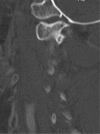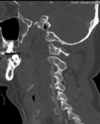Incidence and outcome of atlanto-occipital dissociation at a level 1 trauma centre: a prospective study of five cases within 5 years
- PMID: 23076646
- PMCID: PMC3540318
- DOI: 10.1007/s00586-012-2543-1
Incidence and outcome of atlanto-occipital dissociation at a level 1 trauma centre: a prospective study of five cases within 5 years
Abstract
Background: Prospective evaluation of atlanto-occipital dissociations (AODs) at a level 1 trauma centre within 5 years.
Methods: Over a period of 5 years (2005-2009), all CT scans of the skull base and the upper cervical spine due to traumatic injuries were prospectively entered into a database. Furthermore, in cases of confirmed AOD all empirical data were prospectively collected. A more detailed data analysis of all AOD patients was conducted 2 years post-trauma. If required, another prospective follow-up was performed.
Results: 2,616 CT scans were performed in total. Out of these, there were five male patients with confirmed AOD. Thus, the total incidence was 0.2 %. AOD was associated with occipital condyle fractures in three out of the five cases. Three out of five patients (60 %) died due to the severity of the injury. It was possible to stabilise two patients surgically with a clinical/radiological follow-up 2 years post-surgery. At that time, one patient had an incomplete tetraplegia and was wheelchair ridden without needing ventilation, while the other patient suffered from post-traumatic stress disorder, but was able to walk and live alone.
Conclusions: AOD is a rarely seen injury, even in a level 1 trauma centre, and is associated with high morbidity and mortality. However, it is possible for adults to survive this severe occipito-cervical injury after surgical repair while maintaining the ability to walk. All the results and recommendations are still based on a low level of evidence, due to the low incidence of this injury.
Figures




References
-
- Adams VI. Neck injuries: I. Occipitoatlantal dislocation—a pathologic study of twelve traffic fatalities. J Forensic Sci. 1992;37:556–564. - PubMed
-
- Alker GJ, Jr, OH YS, Leslie EV. High cervical spine and craniocervical junction injuries in fatal traffic accidents: a radiological study. Orthop Clin North Am. 1978;9:1003–1010. - PubMed
-
- Bucholz RW, Burkhead WZ. The pathological anatomy of fatal atlanto-occipital dislocations. J Bone Surg Am. 1979;61:248–250. - PubMed
MeSH terms
LinkOut - more resources
Full Text Sources
Medical

